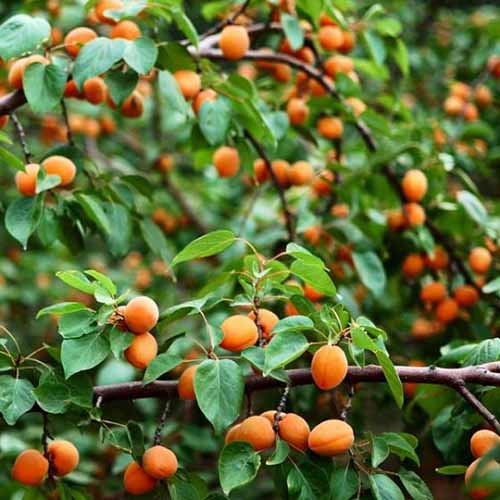The Exotic Apricot Fruit Tree
For thousands of years the Apricot Fruit Tree or Prunus armeniaca has existed with a remarkable historical background. Its origins are traced back to Central Asia, according to scholarly beliefs, while historical data shows its existence in Armenia, China, and Persia. Evidence from archaeology shows that they were cultivated 3,000 years before the common era, which makes them one of the earliest plants humans domesticated. The Silk Road became the primary route through which traders and explorers distributed this fruit tree to diverse cultures. Greek and Roman ancient writings describe its application while Pliny the Elder discussed its attributes. It gained significant appreciation throughout Europe and the Middle East before reaching the Americas where it successfully established itself in regions with appropriate climates.
Healing Properties of Apricot Fruit Tree
For many generations, people have admired Prunus armeniaca because of its tasty fruit and health benefits. Traditional Chinese Medicine has utilized it in treatments targeting respiratory conditions and digestive problems as well as skin diseases. Historical medical practices used fruit kernels for asthma and cough treatments because they were thought to clear lung blockages and reduce irritation. Skincare formulas benefited from oil derived from its seeds because of the emollient properties of the oil which made it widely used.
Throughout history, multiple cultures have recognized its capacity to support digestive health by treating constipation and enhancing digestion. Its high antioxidant content has led people to use it for immune system enhancement and inflammation reduction while also supporting general health. During medieval times in Europe herbalists used it for its reputed power to boost eyesight while promoting better blood flow. Recent studies have confirmed that this food, rich in vitamins A and C.
Discovery and Spread: The First Recorded Encounters
The earliest known interactions with the Apricot Fruit Tree occurred alongside the civilizations that grew it. Ancient Chinese texts from the Han Dynasty (206 BCE–220 CE) show that people used the fruit for cooking and healing purposes. The Silk Road enabled it to extend westward and become highly sought after throughout Persia and the Mediterranean region. The Roman Empire had adopted widespread cultivation of them by the first century CE after Greek and Roman scholars recognized its valuable characteristics. Dioscorides' Greek medical texts outline its healing properties while Roman agriculturalists perfected methods to boost its development. This plant established itself as a fundamental crop across multiple regions that experience hot summers and possess well-draining soil conditions.
Enhancing Gardens and Spaces With The Apricot Fruit Tree
The landscape appeal of Prunus armeniaca has been valued for many years. The tree's elegant shape and seasonal changes deliver year-round beauty. The tree produces delicate blossoms in soft white and pink hues during spring which create a stunning display that resembles cherry and plum relatives. The blossoms draw attention with their visual appeal while their delicate sweet scent adds charm to garden areas.

The plant maintains lush green foliage throughout summer which provides shade and creates a peaceful atmosphere. The plant thrives across different soil conditions and moderate drought conditions, which makes it a preferred choice for landscapers who are creating orchards, home gardens, and urban environments. Its ornamental value extends to supporting pollinators with its power to lure butterflies, which enhances the health of nearby plants. During autumn this tree displays its leaves in brilliant shades of gold and amber which creates a remarkable seasonal transformation leading up to winter dormancy.
Visual Appeal: A Distinctive Presence
Apricot Fruit Trees stand out wherever they are placed because of their unique visual characteristics. The medium-sized form has a rounded canopy supported by gracefully arching branches which produce a balanced and elegant silhouette. Early in the year clusters of blossoms appear on the tree creating a display of delicate pastel tones.
The tree's oval leaves show serrated boundaries and maintain a deep green color throughout the growth period until they turn to warm autumn colors. The bark starts out smooth during the tree's early stage before it becomes textured with slight furrows as it grows older. This tree demonstrates an ideal equilibrium between robust structure and elegant delicacy, which makes it a popular choice for planting in decorative gardens, courtyards, and orchards.
A Haven for Rare Wildlife
Prunus armeniaca plays a vital role in maintaining biodiversity while serving as a magnet for various wildlife species. The plant's flowers serve as a vital source of nectar for pollinating insects including honeybees, native bees and butterflies. The insects sustain ecosystem health through their role in cross-pollination between multiple plant species.
The plant produces foliage and branches that give birds shelter while certain avian species use it as a nesting site. Songbirds use the thick canopy for shelter and other birds feed on its fruit when late summer arrives. Squirrel activities among small mammals enable seed dispersal which helps maintain ecosystem stability. Wildlife depends on this species for essential sustenance during transitional seasons where natural food sources show significant variability.
Its blossoms and leaves attract specific moth and beetle species which enhance its importance in insect biodiversity. Beyond its visual beauty and culinary uses this plant possesses considerable ecological importance by maintaining a dynamic habitat that accommodates various species.
The Enduring Legacy of The Apricot Fruit Tree
Throughout history and across diverse environments the Apricot Fruit Tree stands as a timeless emblem of beauty and strength while serving multiple practical purposes. It has become a beloved element in gardens and ecosystems across the world because of its deep historical roots and its dual benefits in Medicine and visual attraction.